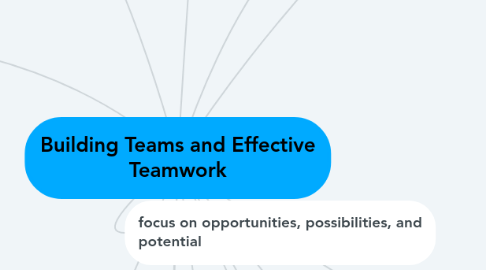
1. focus on opportunities, possibilities, and potential
2. groups of people who are
2.1. interdependent
2.2. interact with each other
2.3. see themselves as unique entity
3. Examples of good teams
3.1. Pagonis team
3.1.1. Logistical Support for the United States Armed Services
3.1.2. textbook example of good teaming
3.2. Graveyard shift
4. High Performing teams
4.1. Attributes include
4.1.1. Performance outcomes
4.1.2. specific shared goals and vision
4.1.3. mutual and interconnected accountability
4.1.4. blurring of formal distinctions
4.1.5. coordinated and shared work roles
4.1.6. inefficiency leading to efficiency
4.1.6.1. think about how 'goofing off' can create camaraderie and better work
4.1.7. creative continuous improvement
4.1.8. high credibility and trust
4.1.9. clarity of core competence
4.2. high quality
4.3. Leading teams
4.3.1. all have two critical factors
4.3.1.1. developed credibility and respect
4.3.1.2. established a motivating vision and goal
4.4. Think of 100 best portfolio convo we had in class
5. Roles on Effective teams
5.1. team members need
5.1.1. task goals
5.1.2. AND roles
5.1.2.1. think of pictures of your brain 'on relationships' vs 'on task'
5.1.2.1.1. toggling
5.2. task related roles
5.2.1. Direction giving • Information seeking • Information giving • Elaborating • Urging • Monitoring • Process analyzing • Reality testing • Enforcing • Summarizing
5.3. relationship building roles
5.3.1. • Supporting • Harmonizing • Tension Relieving • Confronting • Energizing • Developing • Consensus building • Empathizing
5.4. blocking roles
5.4.1. • Dominating • Overanalyzing • Stalling • Remaining passive • Over-generalizing • Fault-finding • Premature decision making • Presenting opinions as facts • Rejecting • Pulling rank • Resisting • Deflecting
6. Definition of team
7. one must:
7.1. 1. manage conflict
7.2. 2. legitimize productive expressions of individuality
7.3. 3. turn counter dependence into interdependence
7.4. 4. foster consensus building among heterogeneous perspectives
8. focus on present
9. focus on specific situation
10. manages agreement and disagreement
11. strategies
11.1. identify common enemy (principle)
11.2. recognition of team performance
11.2.1. encourages team commitment
11.3. maintain visibility of team goals and vision
11.4. have members teach values and core competencies to to others
11.4.1. Xerox dissemination method
11.4.1.1. Learn, Apply, Teach, Measure
12. Team Performance
12.1. can improve by
12.1.1. cutting staffing costs
12.1.2. reducing errors
12.1.3. improving decision making
12.1.4. improving employee relations
12.1.5. increasing performance
12.1.6. increasing innovation
12.1.7. increasing collective self-efficacy
12.1.8. providing social learning models
12.1.8.1. what is this?
12.1.8.2. example?
12.2. can be brought down by
12.2.1. groupthink
12.2.1.1. which is when preservation of group takes precedence over good decisions and problem solving
12.2.1.2. resolutions
12.2.1.2.1. critical evaluators
12.2.1.2.2. open discussions
12.2.1.2.3. subgroups
12.2.1.2.4. outside experts
12.2.1.2.5. devil's advocate- WRONG
12.2.1.2.6. second chance meetings (Pre-Mortem)
12.3. symptoms
12.3.1. illusion of invulnerability
12.3.2. shared stereotypes
12.3.3. rationalization
12.3.4. illusion of morality
12.3.5. self-censorship
12.3.6. direct pressure
12.3.7. mind-guarding
12.3.8. illusion of unanimity
13. Stages of teams
13.1. 1. Forming
13.1.1. one must
13.1.1.1. 1. orient members
13.1.1.2. 2. establish trust
13.1.1.3. 3. establish relationships
13.1.1.4. 4. establish norms, goals, procedures
13.1.2. often feel:
13.1.2.1. self-conscious
13.1.2.2. dependent
13.1.2.3. superficial
13.1.2.4. mild discomfort
13.2. 2. Norming
13.2.1. one must:
13.2.1.1. 1. maintain unity and cohesion
13.2.1.2. 2. facilitate participation and empowerment
13.2.1.3. 3. show support to team members
13.2.1.4. provide feedback on team and team members
13.2.2. where most people are in the production team game
13.3. 3. Storming
13.4. 4. Performing
14. Team Leadership and goals
14.1. Goals
14.1.1. SMART goals
14.1.1.1. Specific
14.1.1.2. Measurable
14.1.1.3. Aligned
14.1.1.4. Realistic
14.1.1.5. Time-bound
14.1.2. Everest goals
14.1.2.1. ultimate achievement
14.1.2.2. inherent value and worth
14.1.2.3. emphasizes: what you can give vs what you can get
14.1.2.4. inherently energizing
14.1.3. Effect of goal on performance
14.1.3.1. Everest has highest effect on performance
14.1.3.2. SMART has second highest
14.1.3.3. Easy goals has lowest
14.1.3.4. No goals has small effect, as does general goals
14.2. Leadership
14.2.1. Developing credibility
14.2.1.1. Demonstrate integrity
14.2.1.2. must be clear and consistent
14.2.1.3. creates positive energy
14.2.1.4. commonality and reciprocity
14.2.1.5. encouraging and coaching
14.2.1.6. sharing information
14.2.2. Feedback
14.2.2.1. focus on behavior
14.2.2.2. focus on observation
14.2.2.3. focus on descriptions of observation
14.2.2.4. focus on sharing valuable information
14.2.2.5. give valuable feedback to reciever
14.2.2.6. must be at appropriate time and place

